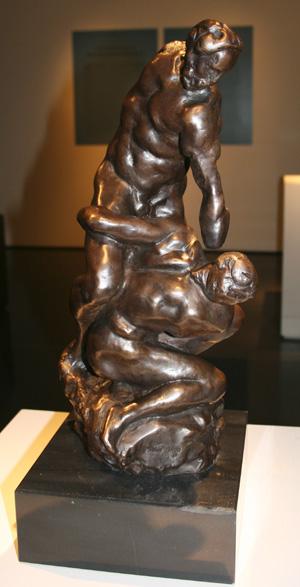
By Anne Marie Amacher
DAVENPORT — “Michelangelo was the most famous sculptor of his time. Many feel he had divine influence,” says Sean O’Harrow, director of the Figge Art Museum in downtown Davenport.
The Figge is the first to showcase a new display entitled “Touched by the Hands of God: Michelangelo’s Models.”
The original models that Michelangelo created during the Renaissance, some in wax and some in wood, were located at the Museo Casa Buonarrotti in Florence, Italy. O’Harrow said bronze replicas of those models were commissioned in cooperation with the Harry and Karly Spell Foundation. Art Casting of Illinois Inc., in Oregon, Ill., produced exact-size replicas using laser technology.
What makes this exhibit different is that it is a hands-on exhibit, which O’Harrow said “adds another dimension” because visitors can touch the bronze models. “How often do you get to touch art?” he asked.
In particular, those with vision impairments will be able to appreciate the art since they can experience it through the sense of touch.
“Michelangelo himself was practically blind in his later years,” O’Harrow noted.
One of Michelangelo’s final sculptures was done in wood and titled “Crocifisso,” which means crucifix. “He was basically blind and did this by touch,” O’Harrow explained. This model was not made into a full-size sculpture, as far as people in the art industry know. “It almost got lost in history.”
Even though Michelangelo was almost blind and the artwork was done in wood, which is harder to sculpt than wax, there is still quite a bit of detail.
The other five pieces on display at the Figge were originally done in wax. They include David, Lourvre Slave, River God, Two Wrestlers and a female nude.
Many of the models closely resemble the final, larger-than-life sculptures Michelangelo and his assistants made.
“Michelangelo was trained as a bronze maker. But, there are no (original) bronzes left — they were all destroyed,” O’Harrow said. So taking his wax and wood models and casting them into bronze “is a new dimension. You can see pure, instant ideas form in his mind and transform into solid form.”
At the Figge visitors can see the intricate details, but the models are not perfect. Over time parts of the original models deteriorated or were damaged. One example is the David sculpture. It is missing an arm in the bronze-cast display.
Even in the small bronze-cast sculptures, the detail of muscles is prevalent. “Michelangelo was a genius in human form and movement. That also is evident in his paintings.”
Michelangelo was an official papal sculptor and painter. “He worked for several popes. He helped build St. Peter’s Basilica. He was at the epicenter of art during his time,” O’Harrow said.
“Michelangelo was the generation of Renaissance artists who exploited the human body. He made the body sensuous and added details that others were unable to achieve.
“He was ahead of his time.”
The bronze-cast models will be on display at the Figge Art Museum through June 7. For more information about the Figge or the Michelangelo display, visit www.figgeart.org.








